Polynomials
Polynomials
A polynomial looks like this:
 |
example of a polynomial, this one has
3 terms
|
Polynomial comes from poly- (meaning "many") and -nomial (in this case meaning "term") ... so it says "many terms"
A polynomial can have:
| constants (like 3, -20, or ½) |
| variables (like x and y) |
| exponents (like the 2 in y2), but only 0, 1, 2, 3, ... etc are allowed |
that can be combined using addition,
subtraction, multiplication and
division ...
subtraction, multiplication and
division ...
... except ...
| ... not division by a variable (so
something like 2/x is right out)
|
So:
A polynomial can have constants, variables and exponents,
but never division by a variable.
Polynomial or Not?
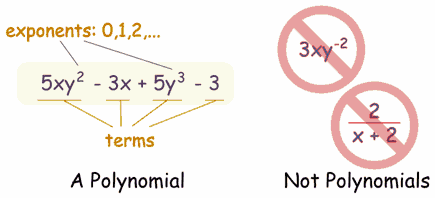
These are polynomials:
- 3x
- x - 2
- -6y2 - (7/9)x
- 3xyz + 3xy2z - 0.1xz - 200y + 0.5
- 512v5+ 99w5
- 5
(Yes, even "5" is a polynomial, one
term is allowed, and it can even be
just a constant!)
term is allowed, and it can even be
just a constant!)
And these are not polynomials
- 3xy-2 is not, because the exponent is "-2" (exponents can only be 0,1,2,...)
- 2/(x+2) is not, because dividing by a variable is not allowed
- 1/x is not either
- √x is not, because the exponent is "½" (see fractional exponents)
But these are allowed:
- x/2 is allowed, because you can divide by a constant
- also 3x/8 for the same reason
- √2 is allowed, because it is a constant (= 1.4142...etc)
Monomial, Binomial, Trinomial
There are special names for
polynomials with 1, 2 or 3 terms:
polynomials with 1, 2 or 3 terms:

| How do you remember the names? Think cycles! |
 |
There is also quadrinomial (4 terms)
and quintinomial (5 terms),
but those names are not often used.
Can Have Lots and Lots of Terms
Variables
Polynomials can have no variable at all
Or one variable
Or two or more variables
What is Special About Polynomials?
Because of the strict definition,
polynomials are easy to work with.
polynomials are easy to work with.
For example we know that:
- If you add polynomials you get a polynomial
- If you multiply polynomials you get a polynomial
So you can do lots of additions and
multiplications, and still have a
polynomial as the result.
multiplications, and still have a
polynomial as the result.
Degree
The degree of a polynomial with only
one variable is the largest exponent
of that variable.
one variable is the largest exponent
of that variable.
Standard Form
Example:
Put this in Standard Form:
3x2 - 7 + 4x3 + x6
The highest degree is 6, so that goes
first, then 3, 2 and then the constant
last:
3x2 - 7 + 4x3 + x6
The highest degree is 6, so that goes
first, then 3, 2 and then the constant
last:
x6 + 4x3 + 3x2 - 7
Division of polynomials:
- Long division for polynomials works in much the same way:
| First, I set up the division:For the moment, I'll ignore the other terms and look just at the leading x of the divisor and the leadingx2 of the dividend. | |
| If I divide the leading x2 inside by the leading x in front, what would I get? I'd get an x. So I'll put an xon top: | |
| Now I'll take that x, and multiply it through the divisor, x + 1. First, I multiply the x (on top) by thex (on the "side"), and carry the x2 underneath: |  |
| Then I'll multiply the x (on top) by the 1 (on the "side"), and carry the 1x underneath: |  |
| Then I'll draw the "equals" bar, so I can do the subtraction.To subtract the polynomials, I change all the signsin the second line... |  |
...and then I add down. The first term (the x2) will cancel out: |  |
| I need to remember to carry down that last term, the "subtract ten", from the dividend: |  |
| Now I look at the x from the divisor and the new leading term, the –10x, in the bottom line of the division. If I divide the –10x by the x, I would end up with a –10, so I'll put that on top: |  |
| Now I'll multiply the –10 (on top) by the leading x(on the "side"), and carry the –10x to the bottom: |  |
| ...and I'll multiply the –10 (on top) by the 1 (on the "side"), and carry the –10 to the bottom: |  |
| I draw the equals bar, and change the signs on all the terms in the bottom row: |  |
| Then I add down: |  |
Factor Theorem :
Remainder theorem:
:Example













No comments:
Post a Comment